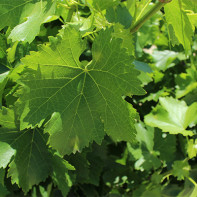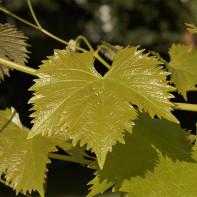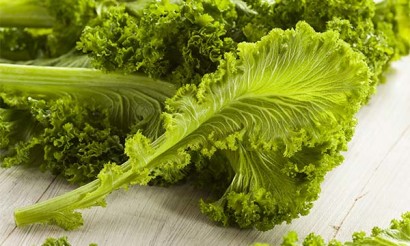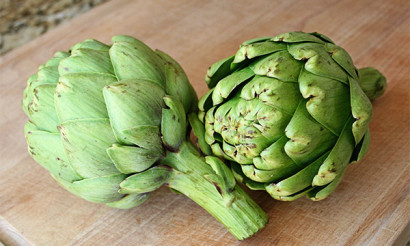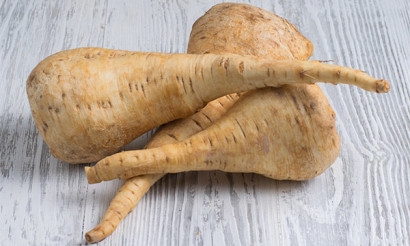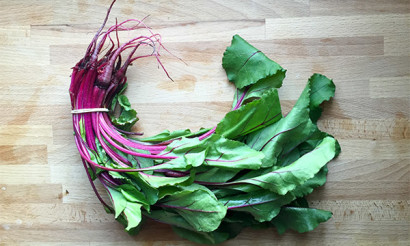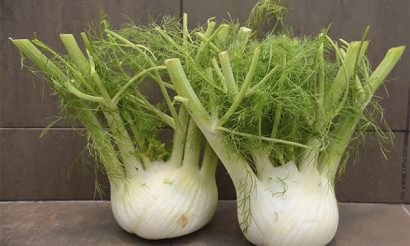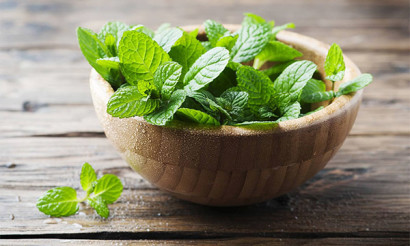Grape leaves: useful properties and contraindications
Grape leaves not only have a pleasant taste, but also contain many useful components. This plant has been used by folk healers since ancient times. But they are not devoid of contraindications.
- Composition and calories
- What are the usefulness of grape leaves
- For Women
- For men
- Pregnancy
- Breastfeeding
- For children
- When losing weight
- Traditional Medicine
- Strengthening tea
- Anti-inflammatory and diuretic infusion
- For gastrointestinal tract and potency
- For gastritis and ulcers
- Infusion of herbal tea for coughs
- Diuretic and anti-inflammatory decoction
- Leaf juice ointment
- Cosmetic applications
- Harm and contraindications
- Collection and storage methods
- Can be frozen
- How to pickle grape leaves
- Recipe 1
- Recipe 2
- Recipe 3
- Recipes for Leafy Grape Leaves
- Dolma
- Chicken Casserole
- Lamb shoulder
- Cheese in grape leaves
- Can I Give Rabbits Grape Leaves
Composition and calories
The caloric value of leaves is extremely low - 93 kcal per 100 g of product. Of this mass, water is 73 g, fats - 2 g, carbohydrates - 7 g, proteins - 7 g and dietary fiber - 11 g.
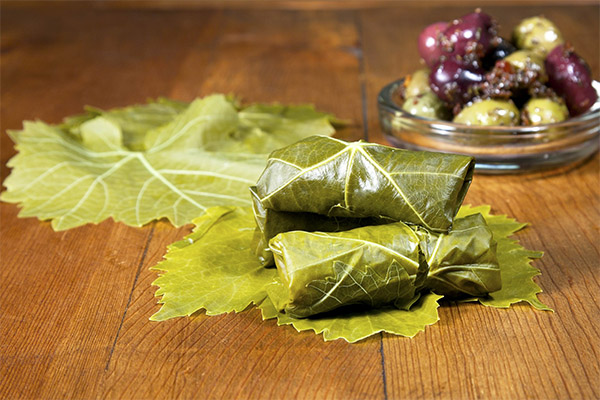
The chemical composition is varied. It contains a large number of substances that play an important role in shaping and maintaining a healthy body:
- Phosphorus. One of the most important minerals for the body. It is used to keep bones strong and healthy. Phosphorus removes toxins from the body, speeds up the repair of damaged tissues, and takes part in the use and storage of energy.
- Calcium. Together with phosphorus takes part in keeping bones strong and healthy. Combined with magnesium improves cardiovascular function. Blocks the absorption of saturated fats by the intestine, thus preventing the development of cholesterol. Participates in the process of muscle contraction, so cramps may occur if there is a lack of the element.
- Potassium. Transfers nerve impulses and maintains water-salt balance in the body. It is an important element that is responsible for protein synthesis and converts glucose into cellular energy.
- Selenium. Makes the body more resistant to disease and stress by improving blood circulation and its antioxidant abilities. It can reduce inflammation and fight free radicals. It improves the cardiovascular system and alleviates many diseases.
- Magnesium. Takes part in most chemical reactions in the body and in the regulation of cell growth. It is an essential element for protein synthesis. Magnesium is also responsible for maintaining normal blood sugar levels and blood pressure. It is beneficial to the nervous system and relieves muscle tension. It is especially important for the cardiovascular system.
- Iron. Improves oxygen metabolism in the body and promotes respiration of tissues. Participates in metabolic processes and hematopoiesis. Supports normal operation of the brain and thyroid gland, strengthens the immune system.
- Sodium. Normalizes water-salt metabolism in the body, improves the production of salivary and pancreatic enzymes. Regulates the acid-base balance in the body and has a vasodilator.
- Manganese. It accelerates wound healing, helps reduce blood sugar levels. Strengthens bones and saturates the body with antioxidants.
- Vitamins B1-B9. Promotes the transformation of fats and proteins into energy, strengthens the nervous system. Can improve the appearance and condition of the skin, nails and hair, participate in the production of hemoglobin. Stimulate the cardiovascular system and normalize blood pressure. Regulate blood sugar levels and take part in fat metabolism. Faster healing of wounds and promote the synthesis of antibodies.
- Vitamin C. Improves cardiovascular function, is very useful for stress due to the soothing effect on the nervous system. It lowers blood pressure and increases the body's defenses. Because of the lack of this vitamin, the immune system weakens and makes people vulnerable to viruses and bacteria. It also reduces the chance of cataracts by 20%.
- Vitamin A. It improves eyesight and enhances the body's defenses. It lowers cholesterol levels and promotes collagen production, which improves skin elasticity. It strengthens the nervous system, improves sleep and metabolism.
- Vitamin E. Stimulates the immune system, is involved in circulatory processes and production of hormones. It also has a positive effect on sugar levels, lowers fatigue, prevents Alzheimer's disease and bladder diseases.
- Vitamin K. Improves blood clotting and is involved in protein synthesis. Responsible for the interaction of calcium with vitamin D and their absorption by the body. It is distinguished by its analgesic effect and is a preventive agent against osteoporosis. It also neutralizes some poisons.
- Omega-3 fatty acids. The human body is almost unable to produce them on their own, so it is very important that they come from the outside. They remove cholesterol from the body, reduce appetite and blunt the feeling of hunger. Omega-3s maintain normal blood pressure and improve blood composition. They also improve memory, restore skin elasticity, and prolong the life of the joints.
What are the benefits of grape leaves
Grape leaves will be beneficial to just about anyone. They have the ability to relieve inflammation, stop bleeding, and relieve stomach upsets. They have a positive effect on the nervous system and improve a person's mood during depression.
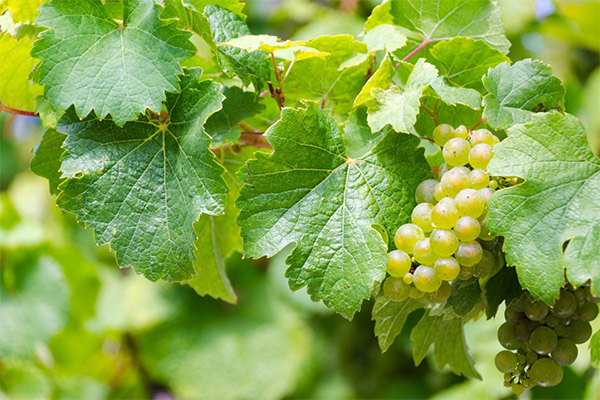
For women
There are known cases of using grape leaves in cosmetology. There are creams and face masks based on this raw material. Folk medicine also uses leaves for this purpose. They can relieve inflammation on the skin, increase its elasticity and fight acne. In addition, thanks to vitamin A, the leaves are a powerful antioxidant and slow the aging process in the body.
They are also used to treat many women's diseases, but it is necessary to consult a doctor before using them. In some cases, they can do more harm than good.
For men
Juice from grape leaves can improve male strength. Grape leaves have anti-inflammatory, antimicrobial and antibacterial properties, so folk healers advise taking them for prostatitis. But this should only be done with the permission of a doctor.
When pregnant
It is not recommended to use grape leaves in pregnancy, especially in the first and second trimester. Excessive use can cause uterine tone, which threatens the abortion of pregnancy. In small quantities they can be useful, but doctors strongly recommend not to use them. Pregnant women have other, safer sources of beneficial substances.
When breastfeeding
Despite the large number of useful substances, grape leaves are not recommended to use during breastfeeding. This plant has a negative effect on lactation. Also, children may have intestinal problems, in particular colic and bloating.
For babies
Children who do not like brushing their teeth, and avoid it in every way, will love the way to fight tooth decay with the use of grape leaves. For this purpose, folk medicine has been using the raw material for a long time - you need to chew grape leaves. What is interesting, the effectiveness of this method is confirmed by many scientific studies. Grape leaves have organic acids, which are the prevention of gum disease, destroy unwanted microorganisms and whiten teeth. The effectiveness of the leaves is so great that one leaf per day is enough. It is not recommended to consume more than that because of the risk of damaging tooth enamel.
Also, children will benefit from grape leaves rich in vitamins, which is important for strengthening the immune system. The consumption of dishes from such greens can improve vision and relieve eye strain.
For weight loss.
Grape leaves are incredibly beneficial for weight loss. First, they contain a low number of calories, secondly, they are rich in vitamins and minerals, and decoction from this raw material has a diuretic effect, which helps to relieve edema. The large amount of plant fibers improves metabolism and digestion, and gives a feeling of fullness for a long time. They can be eaten with dietary meals, or in the form of healing compositions (infusions, decoctions, etc.).
Varicose veins and edema are true companions of overweight. Grape leaf compresses will help to get rid of this problem. They not only improve blood circulation and relieve swelling, but also relieve the pain syndrome. There are even special pills and ointments based on grape leaves.
Application in folk medicine
Folk healers could not pass by such a useful plant, so they began to apply it to treat many diseases. Prepare from the leaves of grapes decoctions, infusions, tinctures, teas and ointments.

Strengthening tea
Tea is more useful to prepare from the dried leaves of the plant. In this form, they have a much higher concentration of useful substances.
To make tea, you need to crush the leaves of grapes and pour boiling water, then leave to infuse for 15 minutes. Before using the brew dilute with boiling water in a ratio of 1:1. The daily dose for strengthening the immune system is 200-250 ml. Such tea increases the protective functions of the body and saturates it with useful substances.
Anti-inflammatory and diuretic infusion
For the preparation you will need fresh leaves of grapes without twigs. Inspect them for damage and rinse thoroughly. Then roll up in clumps and fill a jar of 0.5 liters by 1/3. Then pour boiling water on top of the leaves, cover and put in a dark place for 20 days at room temperature. Every two days you need to shake the jar.
Drink the cure once a day for 10 drops dissolved with 50 ml of boiled water, before a meal. The maximum course of treatment is 14 days, after which you must make a mandatory break, lasting at least a week. You can apply the infusion and externally. To do this, make lotions or rub a cotton swab on the problem areas of the skin.
When stored in the refrigerator shelf life is 90 days, but at room temperature - twice as long.
For the gastrointestinal tract and potency
Tincture is prepared from the young leaves of grapes. As an alcohol base, grape moonshine is ideal, but you can also use regular vodka. You will need a lot of leaves - one liter jar. They need to be carefully washed, remove all twigs and damaged areas, and then put them in a jar, but do not crush. Then pour 1 liter of vodka or moonshine. The jar to seal tightly with a lid, then put in a dark place for 3-4 days. Then strain through folded several times gauze and pour into another glass container.
Drink a few drops diluted with water, 2-3 times a day before meals. Such a tincture improves the gastrointestinal tract, treats some of its diseases (preferably consult a doctor). It will be useful for varicose veins when applied externally for compresses.
For gastritis and ulcers
In this case, you can use grape leaves only with the permission of a doctor and in the amounts established by him. The juice of fresh leaves is used for these diseases. First you need to wash them, then roll them in lumps and grind in a deep bowl until they form a pulp. Then fold the gauze several times, make it like a bag, pour the pulp there and squeeze the juice. It is able to reduce the acidity of the stomach (so you can use only with gastritis with high acidity, not with reduced acidity), gets rid of nausea and vomiting, and softens the mucous membranes. Doses of treatment are chosen individually for each person.
Infusion of herbal collection for coughs
Another version of the tincture is on the basis of an herbal collection. You will need 1 tbsp. spoon of oak bark, 1 tbsp. spoon of raisins and grape leaves. Whole leaves put in a jar so that they occupy 1/2 liter jar, then add other components on top. Pour 0.5 liters of vodka, cover tightly and put for 7-10 days in a dark cool place, shaking every two days. Strain the prepared medicine and drink before eating, diluting a few drops in 1/2 cup of water. Tincture effectively fights coughs, edema and varicose veins, has a restorative effect.
Diuretic and anti-inflammatory decoction
The decoction is also used for compresses for varicose veins, rheumatism and inflammatory processes on the skin. It can improve the condition of the skin and hair.
Decoction is prepared from fresh grape leaves. The plant should be washed, remove the twigs, then extract the juice. Mix it with the pulp with water in a ratio of 1:5, then put on a low heat and boil for an hour, stirring constantly. The finished broth should be infused at room temperature for 2-3 hours, then strain. Drink 1-2 tbsp. spoons before a meal. The course of treatment should not exceed 3 weeks.
Ointment of leaf juice
First you need to get the pure juice. You can do this by crushing the leaves to a pulp and then squeezing them through gauze. The prepared juice must be filtered several more times, so that a clear liquid remains. After that, mix it with honey, so that it remains a thick consistency. Thanks to the honey, the juice of grape leaves will be several times more useful. The ointment can be applied to wounds or inflammations on the skin. It helps with varicose veins and joint pain.
Cosmetic uses
Grape leaves have a positive effect on the condition of the skin. They can nourish the skin, prevent peeling and relieve inflammation. Even traditional medicine uses them as a component for creams. But you can also prepare a cure at home.
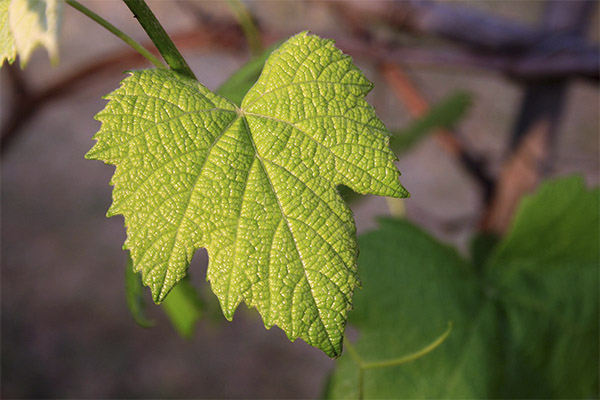
- For facial skin, it is easy to prepare a simple mask. It is able to remove dead tissue and moisturize the skin. To prepare it, you will need a few fresh grape leaves. They should be thoroughly washed, dried and crushed in a blender to a pulp. For the best effect, it is recommended to add 1-2 spoons of flower honey to the mush and mix everything thoroughly. Ready mask is applied to the face, smearing it with an even layer. After 25 minutes, wash it off with cool water. Repeat the procedure several times a day.
- For oily skin suit another recipe. Mash grape leaves in a bowl, then add 10 tbsp. grape juice and 5 tbsp. pure water (preferably use spring water, if not, you can replace it with tea). If desired, add 10 tsp. sweet almond oil. The resulting remedy mix thoroughly, then transfer to an airtight container. You can use a glass jar. Apply the medicine to the skin twice a day - morning and evening, using a cotton swab. It not only tightens the pores, but also cleanses them. After 5 minutes, rinse your face with water and apply facial cream. You can store the medicine in the refrigerator.
- Decoction of grape leaves can improve the condition of the hair. To prepare the medicine, you need to wash the leaves and remove all the twigs and damaged parts. Then mash them to a pulp and separate 100 g of the resulting mass, which pour 2.5 glasses of boiled water. A container with leaves put on low heat, cover and cook for an hour. During this time, the amount of liquid should decrease by one-third. Infuse until completely cooled, then strain through folded gauze several times and pour into a glass container. Use to rinse hair after shampooing. Decoction gives them volume and shine, preventing hair loss, can get rid of dandruff. You can also add it to shampoo.
Harm and contraindications
It is important to remember that only a healthy leaf of grapes can benefit the body. You need to pay attention to everything - the shape of the leaf, its color, its structure, as well as the petiole opening. For example, if the leaf is bent at the edges or begins to dry out, it should not be eaten. Leaves should be light, usually darkening is characteristic of autumn, and if this occurs during the collection period, it is better to refrain from harvesting such a leaf.
A particularly dangerous caveat is the white patina on the surface. This indicates a lesion of microorganisms, which can only be seen with a microscope. Once in the body, they can cause many problems. The leaves, which are covered with spots, should also be ignored.
Therefore, in order not to be left without medicinal raw materials, it is necessary to treat it from pests in a timely manner. Usually this is done when the fifth leaf on the shrub grows. If it is not possible to avoid the appearance of diseases, it is necessary to correctly identify the ailment and get rid of it.
Grape leaves - is a valuable product for the body, but it should be used in moderation. Exceeding the permissible dosage may cause the development of gastrointestinal diseases. It is forbidden to take grape leaves during pregnancy, breastfeeding, gastritis with reduced acidity. It is also not recommended to eat them with asthma, kidney failure, diabetes, heart failure and cancer. In the presence of such pathologies, you can take the leaves only after a doctor's permission.
Healthy people would also do well to consult with a doctor - in some cases, there may be an individual intolerance to the plant, which leads to serious health problems.
Collection and storage methods
In order for the plant to retain its positive properties as long as possible, it is necessary to adhere to some rules and peculiarities of collection.
Particular attention should be paid to the time of collection. It is recommended to do it during May-June. For medicinal purposes, it is better to use only young leaves. Their surface should be soft and smooth, and the veins should be thin. It is preferable to harvest the leaves for medicinal purposes in sunny weather in the morning, when the dew has not yet had time to disappear completely. Leaves are plucked along with the twigs, but they should always be removed before using.
Leaves can be stored in various ways, but dried is the best way to go about it. To dry the leaves, first rinse them thoroughly and then remove any twigs and damaged parts. Then twist the leaves into envelopes and put them one by one on a baking tray. Dry them at 60-65 degrees for at least 6 hours with the door open. Then leave them to cool and pour into a cloth bag. Store the leaves at room temperature, ventilating them from time to time. The shelf life of such raw materials is one year.
To preserve the green leaves, they can be salted. To do this, they need to be washed, put in any airtight container, which first thoroughly rinsed and dried. Next, prepare a salt solution. To store the leaves, the concentration of salt in water 10% is enough, so you need to mix it with water in the proportion 1:10, for example, for 30 g of salt 300 ml of water. Pour the grape leaves up to the top with the liquid, then cover and put in a cool place.
Another way to preserve the greens is to preserve them. The washed leaves should be twisted into tubes, then placed for 3 seconds in boiling water, and then immediately into cold water. Then place them in glass jars and pour the brine, which is prepared at a rate of 40-45 grams of salt per 1 liter of water. Put the jars in a dark place for 2-3 days, then add there 1 tsp. vinegar and preserve. Store in a pantry or cellar.
Can I freeze
Freezing is another way to store grape leaves for a long time. First, the raw material must be prepared - thoroughly wash and remove all twigs. Then lay out the leaves one on one, in stacks of up to 12 pieces, roll them up in tubes. It is recommended to dry them in the oven beforehand, so that they are not too brittle. Then, rolled into rolls, pack them in tight bags (food wrap and sacks crumble a lot) and, letting all the air out of there, put them in the freezer. Since grape leaves are quite brittle, it is advisable to place the rolls in a solid container - this can be a regular plastic food container. It is also recommended that each roll be signed. On the leaflet, the date the leaves were harvested and the date they were placed in the freezer should be indicated. The shelf life of grape leaves is up to 8 months. After that, they lose flavor and useful properties and become dry.
Defrosting takes place in several stages. First, the rolls should be moved from the freezer to the refrigerator. When the ice melts, keep them at room temperature. You can also put them in boiling water after the freezer and wait for all the moisture to be absorbed. Grape leaves are not re-freezeable, so thaw not all at once, but as needed.
How to pickle grape leaves
There are a large number of recipes for marinating grape leaves for the winter, but among them separately stand out 3 main, which are the most popular.
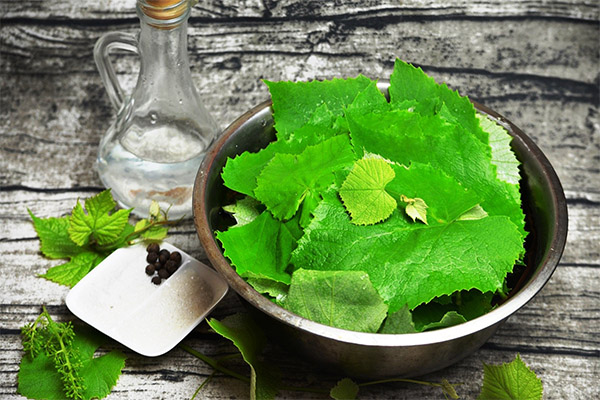
Recipe 1
Armenian dish dolma is stuffed cabbage rolls made of grape leaves. Very often marinated leaves are used, which are prepared very simply. For this you will need:
- 100 leaves of grapes;
- 3 liters of water;
- 3 tablespoons of salt.
The leaves should be well washed, cut off the stems, and then dry them in a thin layer on a towel. While they are drying, you can prepare a marinade - pour water into a pot, add salt, and bring to a full boil. Dried leaves stack in small stacks of 10-15 pieces, then roll up and stack tightly in a jar vertically. Pour the boiling brine into jars, and then close them with metal lids, although you can simply close with plastic lids. Store the pickled leaves should be in a cool place, you can even in the refrigerator.
Recipe 2
Another method of pickling involves the use of lemon. Such leaves not only acquire a refined taste, but also become several times healthier and can be effectively used for acute respiratory infections and diseases of the gastrointestinal tract. Pickled with lemon leaves have anti-inflammatory and antibacterial properties. To prepare it will require:
- 1 lemon;
- 40 g sugar;
- 20 g of salt;
- 500 ml of water;
- 25 grams of citric acid;
- grape leaves.
Wash the leaves and leave them to dry, also rinse the lemon and grate the zest with a special grater, then cut into small slices. Grape leaves lay out 5-6 pieces and roll up, then place in jars, interspersing each tube of leaves with a slice of lemon. Put water on the stove, add salt, acid, sugar, then bring to a boil. Pour the liquid into jars and cork them tightly, then put them upside down in a warm place for a day.
Recipe 3
Another interesting recipe is pickled grape leaves with mustard. This option is great for people who don't like to use vinegar. With this recipe, you can keep the leaves fresh, with a natural flavor. It requires the following ingredients:
- 1 tsp. mustard powder;
- Grape leaves;
- 1 tsp. salt;
- 0.25 tsp. ground black pepper.
Rinse the leaves thoroughly, then put them in boiling water for a few seconds. Then roll them in tubes of 10 pieces and put them into jars. Add salt, mustard powder and pepper to each jar, then pour boiling water over it. Container to roll up, turn over and put in a warm place until completely cooled, then move to a permanent place for storage of canned food.
Recipes for dishes with grape leaves
Due to their pleasant taste, grape leaves are used to prepare a variety of dishes.
Dolma

It is an Eastern-style stuffed cabbage rolls where grape leaves are used instead of cabbage leaves. In Armenia dolma is always cooked for holidays. The most important secret of cooking the dish is to use only young and fresh leaves, otherwise the taste will be completely different. For cooking we will need:
- 1 kg of beef tenderloin;
- 500 g grapes leaves;
- 2 to 3 large onions;
- 2 bell peppers;
- 100 g tomatoes;
- 100 g rice;
- cilantro to taste;
- 2 tbsp dried basil;
- 150g butter;
- salt/spices to taste.
First you need to prepare all vegetables and meat. Pour the leaves of grapes in boiling water and leave them for 5-10 minutes. With tomatoes remove the skin. To make it easier to do this, put boiling water on them. Peel onions and cut each head into 4 parts. Peel peppers, remove white film from the meat.
Next, you need to put the beef with butter, herbs and vegetables through a meat grinder, then add salt, spices and mix everything thoroughly. Next, add the raw rice and mix everything again. Lay leaves streaked down on a table, carefully removing tough tails to prevent damage. In the center of each leaf, place a small portion of meat, no bigger than a walnut, and wrap, but not too tightly, otherwise the boiled rice may tear them.
Place the leaves with the stuffing in rows on the bottom of the pan, cover with water and press down with a plate so that the rice cooks evenly. Bring to a boil, then turn on low heat and simmer for another 40 minutes. Serve on plates with the sauce.
Chicken Casserole
This is a delicious dish that can be prepared for every day and for the holiday table. Grape leaves give the dish a special flavor and spiciness. To prepare it, you will need:
- 200 g of cheese;
- 12-15 grape leaves;
- 6 tablespoons of wheat flour;
- 3 eggs;
- 2 tablespoons vegetable oil;
- 200 g cottage cheese;
- 500 g of chicken fillet;
- 1 zucchini;
- 1 tsp. baking powder;
- Greens/salt/spices to taste.
First grate the zucchini and 100g of cheese, then finely chop the herbs and add to the ingredients, mix well and add flour. Add cottage cheese, baking powder and vegetable oil to the eggs. Add salt, stir and add to the cheese and zucchini, stir once again.
Layer the baking dish with grape leaves. Pass the chicken fillet and onion through a meat grinder, add the egg, spices, and roll into balls.
Place the zucchini batter on the leaves, and add the balls on top and bake for 40 minutes at 200 degrees. At the end, sprinkle the casserole with the remaining 100 g of cheese grated on a fine grater.
Lamb shoulder
You can really surprise your guests with this dish. It is unlikely that any of them have heard of such an interesting delicacy. To prepare the dish, you will need:
- 1 kg of lamb shoulder or 1 leg;
- 2 kg of salt;
- 3 eggs;
- 7-10 grape leaves;
- 1 tsp. thyme;
- 2 sprigs of mint;
- 1 tbsp. dried ajika;
- 1-2 sprigs of barberries;
- 10 small potatoes;
- 10 garlic cloves;
- Greens to taste.
Lamb is thoroughly washed and dried with a towel, then rub with dry adjika. Greens are also washed and dried, vine leaves are placed on a sheet of parchment, put the meat on top of them, and on top of it the rest of the herbs and spices.
In a deep bowl mix the salt with the eggs. It is better to do this with your hands. Put salt and eggs mixture on top of meat with herbs and form a crust. Put parchment with meat on a baking tray and put it in a preheated oven to 150 degrees. Bake the dish for 90 minutes.
Peel potatoes, wash them, squeeze garlic on top and mix thoroughly. If desired, you can add other spices. Bake the potatoes along with the meat. When ready, decorate with herbs.
Salt shell off the meat (sometimes you have to do it with a hammer), transfer the lamb to a dish. Serve with potatoes and other vegetables.
Cheese in grape leaves
This is a very simple, yet delicious and healthy snack. You can take it with you on a picnic or on the road. This incredible treat is not only delicious, but also healthy. To prepare the snack, you will need:
- 250 g of your favorite cheese;
- 12 grape leaves;
- 20 ml of red semi-dry wine;
- 1.5 liters of water.
First wash the leaves, then put them in a saucepan, pour boiling water, cover and let stand for 2 minutes. Cut the cheese into small pieces and wrap each of them in a grape leaf. Then put everything into a saucepan, pour the wine and press with something heavy. After 24 hours, the dish will be ready.
Can I Give Rabbits Grape Leaves
Giving rabbits grape leaves is not only possible but necessary. They contain vitamin A, which improves the stomach and nervous system in rabbits. It also helps improve reproductive function. Vitamins B and C are also very important for their bodies - they strengthen the immune system and normalize digestive function. If rabbits get enough of these vitamins regularly, they will have a soft, shiny coat.

By eating a few leaves a day, rabbits will get their daily allowance of micronutrients. Magnesium is especially important for the normal growth and development of rabbits and is abundant in leaves. As a supplement to the basic diet, it is recommended to give leaves to lactating rabbits.
But do not get too carried away with grape leaves. Firstly, the diet of rabbits should be varied, and secondly, the leaves contain glucose, which in large quantities can cause obesity, digestive problems and cause dysbiosis. The leaves should be dried beforehand - in this form they digest better in animals. If grapes have been treated with chemicals, the leaves must first be washed.
Veterinarians advise to give rabbits 1-2 leaves to try, and then observe their condition. Sometimes unfamiliar food can cause problems in the gastrointestinal tract. If this happens, then give the treats no further.
It is also worth remembering that only homemade grapes should be given to rabbits. The leaves and fruits of the wild are not suitable for food, although they often grow in plots as an ornamental plant.
Leaves of grapes are a valuable and accessible source of nutrients for the body. It is difficult to find a garden plot without this plant. But, as they say, everything is good in moderation. If you do not exceed the recommended doses of consumption of leaves, you can get the maximum benefit from the plant.
«Important: All information on this site is provided solely for introductory information on this site is provided solely for educational purposes. Consult with a health care professional before using any of our recommendations. specialist before using any of the recommendations. Neither the editors nor the authors shall be liable for any possible harm caused by materials."



